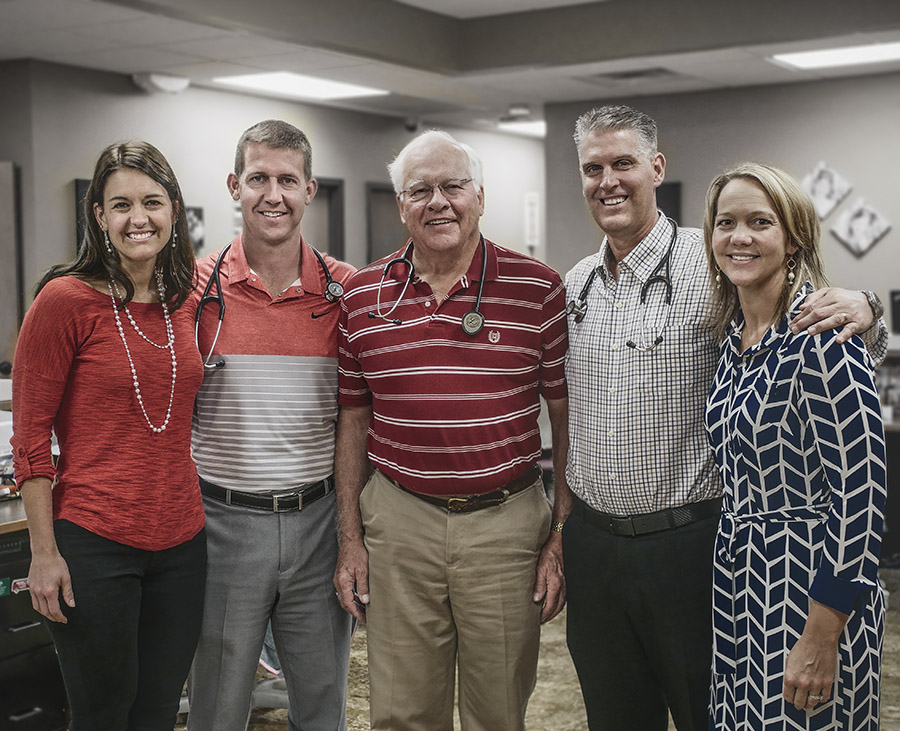Sumner County Family Care Center clinic partners
From Left: Lacie Gregory MD, Stephen Hawks DO, Joel Weigand MD, Steven Scheufler MD, Shana Jarmer MD, (not pictured Larry Anderson MD)
Amber Dawson hadn’t been at her new job as Administrator of Sumner County Care Center more than a few days when she ran across an email from Practice Transformation Network advisor Jill Daughhetee.
The Sumner County Care Center in Wellington has 11 providers and 30 employees and is celebrating 40 years of service this year. However, a recent string of turnovers in the administrator position had left the lines of communication down and employee morale down, too. Amber wanted to change that and Jill’s email offered some tools.
Jill is a Quality Improvement Advisor with Kansas Healthcare Collaborative’s Practice Transformation Network (PTN). One of the tools she offers members is a PDSA worksheet. “It stands for Plan/Do/Study/Act,” she explained. It is an organized approach to quality improvement by asking the questions like “What do we want to improve? Where are we now? Where do we want to be? When do we want to be there? What are the steps we need to do to meet this goal? Who will do the work and when will they do the work? How will we know our change had a positive impact?” The worksheet is very simple, so simple that anyone can use a PDSA to guide quality improvement.
“Amber embraced use of the PDSA,” Jill said, “and that quickly resulted in improvement in five of our Transforming Clinical Practice Initiative (TCPI) change concepts which all PTN practices recognize from our Practices Assessments performed every six months.”
2.2.1 Practice uses an organized approach (e.g. use of PDSAs, Model for Improvement, Lean, FMEA, Six Sigma) to identify and act on improvement opportunities.
At their first meeting, Jill said Amber recognized the potential of the PDSA to help her address the personnel problems.
“I was thinking on a very broad scale,” Amber said. “Communication had broken down and things were deteriorating. I wanted to bring everybody back together. We’re all here for one goal and that’s the patient. I wanted to find a way to keep staff motivated and excited to come to work.”
2.2.2 and 2.2.3 Practice builds QI capability in the practice and empowers staff to innovate and improve.
She started with lots of meetings –meetings with the doctors, meetings with the supervisors, meetings with front end staff, and quarterly meetings that brought everyone together. She began incorporating the PDSA tool into the meetings, using it to identify areas that needed improvement, and making the meetings worthwhile and productive, “not just meetings for the sake of meetings,” she said, “I told them, ‘Bring your PDSA and we’ll talk about where you are.’”
Amber explained that with a number of departments intertwined, improvements in one area could affect another. For example, if front end staff were careful to enter information correctly, that reduced the number of insurance claim re-files.
1.2.2 Practice sets clear expectations for each team member’s functions and responsibilities to optimize efficiency, outcomes, and accountability.
Since starting her position in February, Amber is encouraging staff to use the PDSAs for their annual evaluations as well. “We can look at it during their review and they can show their improvement.”
Practice has met its targets and has sustained improvements in practice-identified metrics for at least one year.
She is also seeing its influence as staff start to initiate new projects. “They’re getting innovative and every day they are thinking about new ways to move the clinic forward. This lets them put their own thought into it, because they can recognize ways to improve those daily tasks better than I can.” Additionally, she said, they begin “to feel like they have a voice again, that their opinion matters.”
“The PDSA will help me, too,” Amber said, as she has plans to increase community involvement, design a new website and more. Measurable improvement will also be helpful when she wants to talk to management about hiring more staff. “I’ll have the numbers to back up my case.”
3.2.3 Practice has effective strategies in place to cultivate joy in work and can document results.
Morale is improving, too. The staff is finding opportunities to get together outside of the office, to celebrate baby showers and weddings, and have some fun together.
Amber is quick to thank Jill for the assistance. “There’s never been a time when she’s not been available to help me, even if it was a quick phone call or email. She’s really been my life support. Additionally, Jill was helpful in connecting me with others who have similar situations. That networking has been helpful, too.”
“Amber is a great example of a leader who embraces quality improvement and empowers staff to innovate and improve,” Jill said. “She was already wanting to map their improvements and she recognized right away that she could use the PDSA in a number of ways to help the practice. When a practice begins to incorporate the change methodology throughout the practice, we start to really have fun making impactful improvements.”
“We’ve been taking advantage of all the potential,” Amber said of the tools Jill brings, at no charge, through the KHC PTN. “It’s already been quite a year.”
